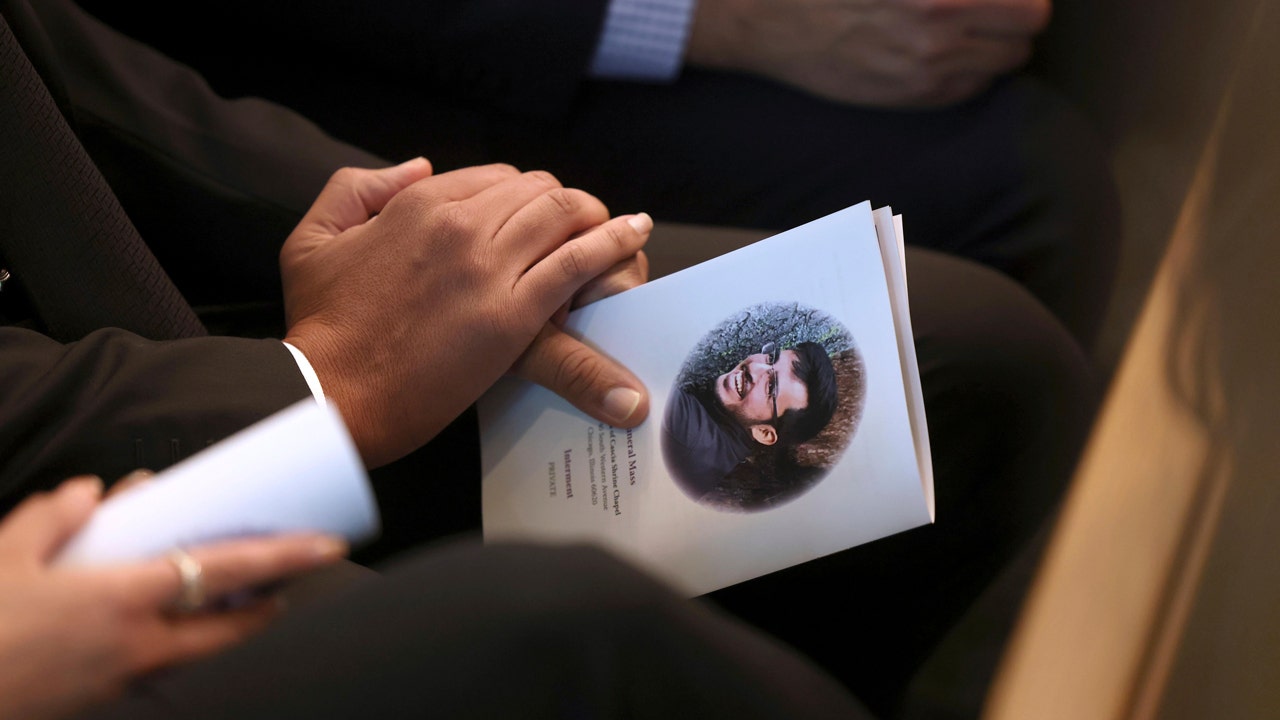Business
Money Talk with Liz Weston: Handling family property, when to take retirement and building credit history

Dear Liz: My wife and I plan to leave our house to our four children. My concern is that one may want to sell and split the proceeds; another may want to keep the house, rent it and divide up the income; and of course there’s always the real possibility that one may want to move in and live in it (we live in a nice community in California). My goal is to prevent doing anything that drives a wedge between them. Any advice on how best to approach this issue short of requiring the house be sold?
Answer: You’ve identified some of the complicating factors of leaving property to multiple heirs. There are many others, including changing circumstances and inclinations. The one who now wants to move into the property may be nicely settled elsewhere when the time comes. Or the one who’s keen on creating a rental may decide that screening tenants, collecting rent and fielding 3 a.m. calls about plumbing problems is too much hassle. Some of the heirs may be in a better position than others to absorb the ongoing costs of maintaining the home, including taxes, insurance and repairs. Even if their financial circumstances are roughly equal, they may have trouble agreeing on the timing and cost of repairs or improvements. And that’s assuming there are no reversals of fortune. Someone who is adamant about keeping the home may find themselves in need of funds later. And so on.
Your life isn’t immune to change either, by the way. You, or your widow, may want to downsize someday or need to sell the house to fund long-term care needs.
An experienced estate planning attorney can help you sort through your options because this is a common scenario and one that can be approached in different ways, including requiring the house to be sold, creating a trust or forming a family partnership to manage the property.
The attorney also can help you frame the discussion you’ll want to have with the kids. Knowing their current preferences and circumstances may be helpful, but given your goal, it’s also a good opportunity to emphasize the importance of family unity. Let your kids know you expect them to put family first and that harmonious relationships are worth more than any piece of real estate could be.
Dear Liz: I am recently divorced but was married for 20 years. My ex is 12 years older and he waited until 70 to start collecting Social Security benefits. I am 62 and self-employed. My retirement benefit is greater than half of his (but not by much). It is my understanding that after his death I can collect his full benefit, provided I am at least 67 when I apply, even if I start taking my own benefit now at 62. Is that correct?
Answer: Yes, but he could live a long time. Starting your own benefit now means you’ll get much smaller checks for years, perhaps even decades, compared with what you’d get by waiting. Plus, any benefit you take before your full retirement age would be subject to the earnings test, with $1 withheld for every $2 you make over a certain amount ($22,320 in 2024).
You may not have much choice, but if you do, waiting to apply is usually the best option.
Dear Liz: You recently answered a question from someone who was rejected for a credit card because of a lack of credit history. Years ago, my wife was rejected for similar reasons. She signed up for a card with a local retailer, then successfully reapplied for the credit card six months later. Maybe the industry has consolidated enough that this won’t work anymore, but it did then.
Answer: Retail cards are often easier to get than credit cards, although these days people also can start their credit histories using secured cards or credit-builder loans. Secured cards offer a credit line equal to a deposit made to the issuing bank. With a credit builder loan, the borrowed amount is stored in a savings account or certificate of deposit that the borrower can claim after a set number of monthly payments.
The original questioner already had a credit history, however, along with high credit scores. The issuer that rejected their application cited a lack of an installment loan history. In other words, there was no mortgage, student, auto or personal loan showing on their credit reports. That’s not something that typically would keep someone from getting approved for a credit card, hence the recommendation that the questioner call the issuer and ask for a reconsideration.
Liz Weston, Certified Financial Planner®, is a personal finance columnist for NerdWallet. Questions may be sent to her at 3940 Laurel Canyon, No. 238, Studio City, CA 91604, or by using the “Contact” form at asklizweston.com.

Business
MLB ghost kitchens to whip up ballpark food for delivery and pickup, courtesy of IHOP

The concept is curious. Turn 347 International House of Pancakes locations nationwide into ghost kitchens that produce ballpark-themed fast food for delivery and pickup.
Ballpark Bites outlets have sprung up seemingly overnight, 44 in California alone, second only to the 76 in Texas. Maybe that’s how ghost kitchens roll.
Major League Baseball is sponsoring the venture, which mirrors the NASCAR Refuel Tenders & Burgers initiative that also utilizes IHOP kitchens — although regrettably neither menu offers the Rooty Tooty Fresh ‘N Fruity. Already, 524 NASCAR Refuel are in place, and the company motto is (of course) “We’re growing FAST!!!”
Attaching hugely popular, deeply American professional sports to a fast-food venture is the brainchild of Virtual Dining Concepts, owned by Planet Hollywood founder Robert Earl. The company website boasts of 3,000 virtual restaurants, 2,000 restaurants, 6 million orders, and — apparently — counting.
The recipe is simple. Offer what folks typically eat at a ballgame or an auto race for less than the exorbitant prices charged at those venues, slather menu descriptions with a heaping helping of cringe-worthy puns and plays on words, and utilize delivery services to get the grub to couch potatoes glued to their favorite televised ballgame or race.
Like most fast-food chains, the menu at every MLB ghost kitchen is identical, right down to sandwiches served on the same soft pretzel bun. The “starting lineup” offers chicken strip sandwiches, hot dogs, a sirloin tips sandwich and a cheesesteak. A combo plate is called “the triple play” and “the closer” is a ball bucket of doughnut holes tossed in cinnamon sugar.
“We understand that not everyone has the opportunity to visit an MLB or [minor league] ballpark, so we wanted to create Ballpark Bites for fans to enjoy a part of that experience from the comfort of their own home, a local park or even at work,” said Karin Timpone, MLB executive vice president and chief marketing officer.
Reaction on social media and traditional media dings MLB for the sameness of the menus. “You’d think a national organization like MLB would lean into the regional specialties of its ballparks, but nope,” SFGate wrote.
Blowback would be inevitable, however, if attempts to replicate favorites unique to specific ballparks failed — if San Francisco garlic fries or L.A. Dodger Dogs or whatever didn’t taste authentic. Furthermore, most regional ballpark offerings are inferior versions of what is available outside the ballpark, like crab cakes in Baltimore, cheesesteak in Philadelphia, barbecue in Kansas City or deep dish in Chicago.
Who is going to seek out a city’s signature culinary offering from MLB prepared in an IHOP presented by Mastercard?
NASCAR Refuel Tenders & Burgers follows the same script with menu descriptions in overdrive. Choose between Talladega, Hot Lap or Full Throttle tenders, the Daytona Firecracker burger or the Checkered Flag chicken sandwich.
Or, as IHOP views them, revenue fuel.
“Our work with [Virtual Dining Concepts] and the three brands we’re implementing will be a growth driver for our restaurants, specifically as we look at non-peak hours during lunch, dinner and late night,” IHOP president Jay Johns said in a statement. “These new brands are relevant for today’s consumer and perfect for our existing equipment and capabilities in our restaurants nationwide.”
Whether ballpark and racetrack food remains appealing enough off site to support hundreds of locations remains to be seen. If it does, plenty of kitchens are available. As of April 3, 1,699 IHOP restaurants operate in the United States.
The state with the most? California, with 225 locations.
Business
California climbers train for Mt. Everest from the comfort of their own beds

Graham Cooper sleeps with his head in a bag.
Not just any bag. This one has a hose attached to a motor that slowly lowers the oxygen level to mimic, as faithfully as possible, the agonies of fitful sleep at extreme altitude: headaches, dry mouth, cerebral malaise.
“It’s not all bad,” Cooper insisted, nodding to the humming motor. “That’s like white noise.”
Cooper, 54, an Oakland biotech executive who has handled finance for a number of companies, including one that sold for $7 billion, isn’t a masochist, exactly. He’s acclimatizing, in the bedroom of his second home near Lake Tahoe, for an attempt to climb Mt. Everest in May.
Graham Cooper uses a pulse oximeter to check his blood oxygen levels and pulse rate at his Truckee home.
He has signed up with an Olympic Valley-based guide service whose founder, Adrian Ballinger, is breaking with decades of tradition to create what he believes are better and more ethical ways to climb the world’s tallest mountain.
Ballinger said he was appalled by the risks, filth and ballooning crowds on the traditional southern trek up the mountain in Nepal. That’s the route familiar from countless documentaries and books, including the 1997 classic “Into Thin Air.”
So he decided to take clients up on the north side, a journey that starts in Tibet.
“It’s colder, the route is more difficult, and the bureaucracy of dealing with China and getting the permits is a complete nightmare,” Ballinger said. “But despite those things, the Chinese are attempting to regulate, so once you get on the mountain, it’s safer, it’s cleaner, and it’s much less busy.”
Ballinger is also pioneering a technique he calls “rapid ascent,” which cuts the duration of the expedition roughly in half: from about two months to about one. That suits his clients, who usually have more spare money than time. And it buys Ballinger more time to spend at home with his wife and newborn son.
The catch? You have to spend a few months before the trip with your head in the bag.
“It’s not great, I’m not gonna lie,” Ballinger said with a laugh, but the technology is improving.

Graham Cooper has been diligently training for his Mt. Everest climb, a regimen that includes skiing laps up and down the slopes near his Truckee home.
(Brian van der Brug / Los Angeles Times)
“Hypoxic tents,” as they’re called, have been used by other endurance athletes for years. In their original form, they would cover a client’s entire bed. That led to difficult conversations with spouses and partners about the necessity of sleeping at progressively higher simulated altitudes until they reached the height of Everest’s base camp, roughly 18,000 feet, where there’s about half the oxygen available at sea level.
As you can imagine, some clients wound up relegated to a couch with their bizarre-looking contraptions.
Cooper, who used one of the enormous old tents preparing for a 2015 trip to climb the highest peaks in Antarctica and South America, confessed he had no luck sweet-talking Hilary, his wife of 28 years, into sharing the adventure. He got bounced to a guest room.
“It was a lonely boy-in-the-bubble experience,” he said. But he has fond memories of the looks on his kids’ faces as they trooped into his little dungeon to kiss him good night.
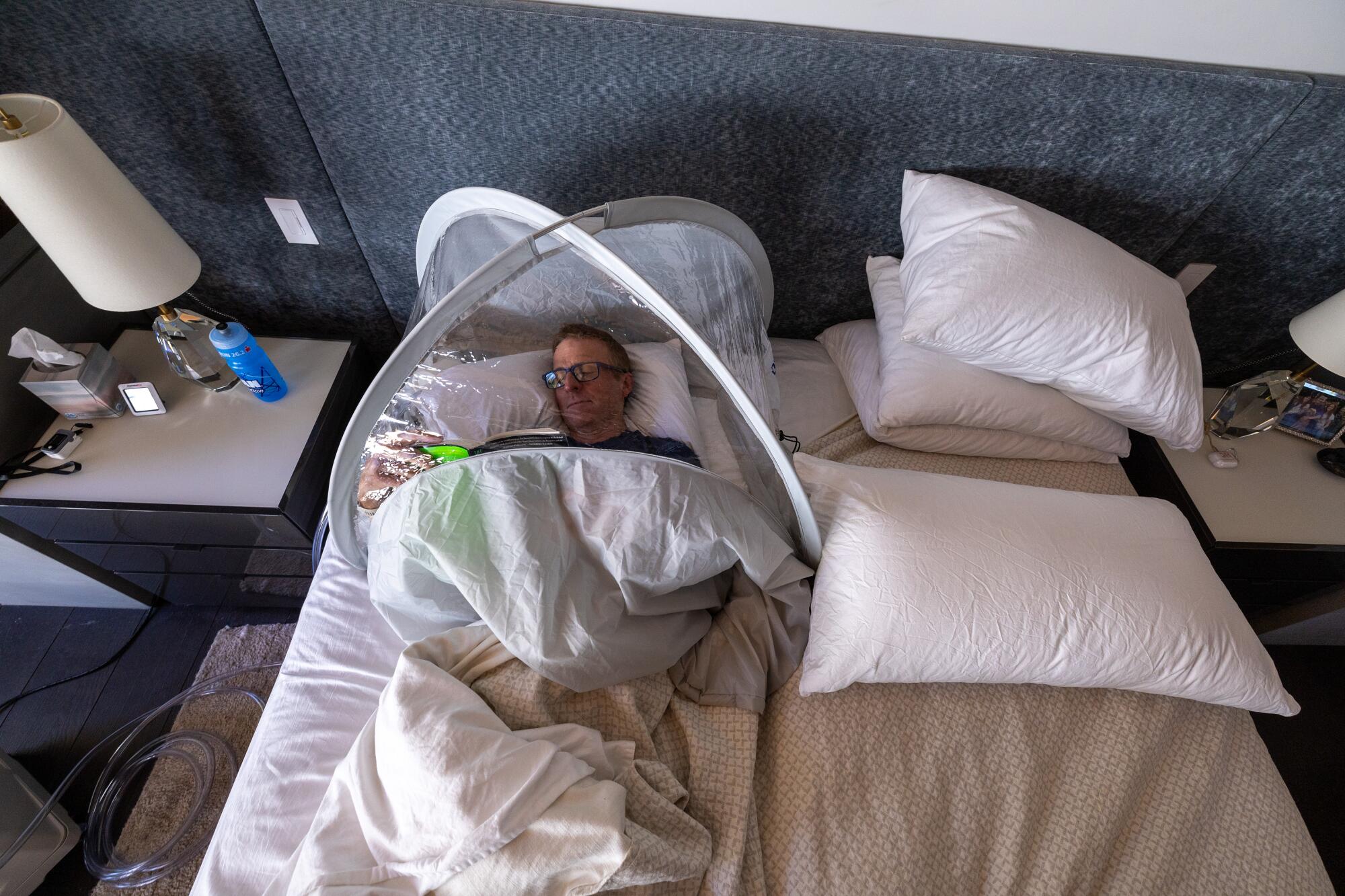
Graham Cooper relaxes with a book inside an hypoxic tent that slowly lowers the oxygen level to mimic conditions at extreme altitude.
This time around, “the bag,” as he calls it, covers just his head and upper torso and takes up about a quarter of the bed. Hilary sleeps next to him, Cooper said, and she finds the hum of the motor surprisingly soothing.
It goes without saying that the luxury of acclimatizing at home, in bed, with your partner curled up beside you, represents a profound break from the usual manner of preparing to ascend what is still one of the world’s deadliest mountains.
The traditional method starts in Kathmandu, at nearly 5,000 feet, where climbers spend a few days getting over jet lag. That’s usually followed by a quick flight to the small mountain town of Lukla, at just over 9,300 feet. The airport there — perched on a narrow Himalayan shelf surrounded by towering peaks, with a steep drop-off at the end of the runway — is regarded as one of the trickiest places in the world to land an airplane.
From there, climbers begin a long, deliberately slow 10-ish-day hike to base camp. The point is to give the body time to gradually adjust to the lack of oxygen.
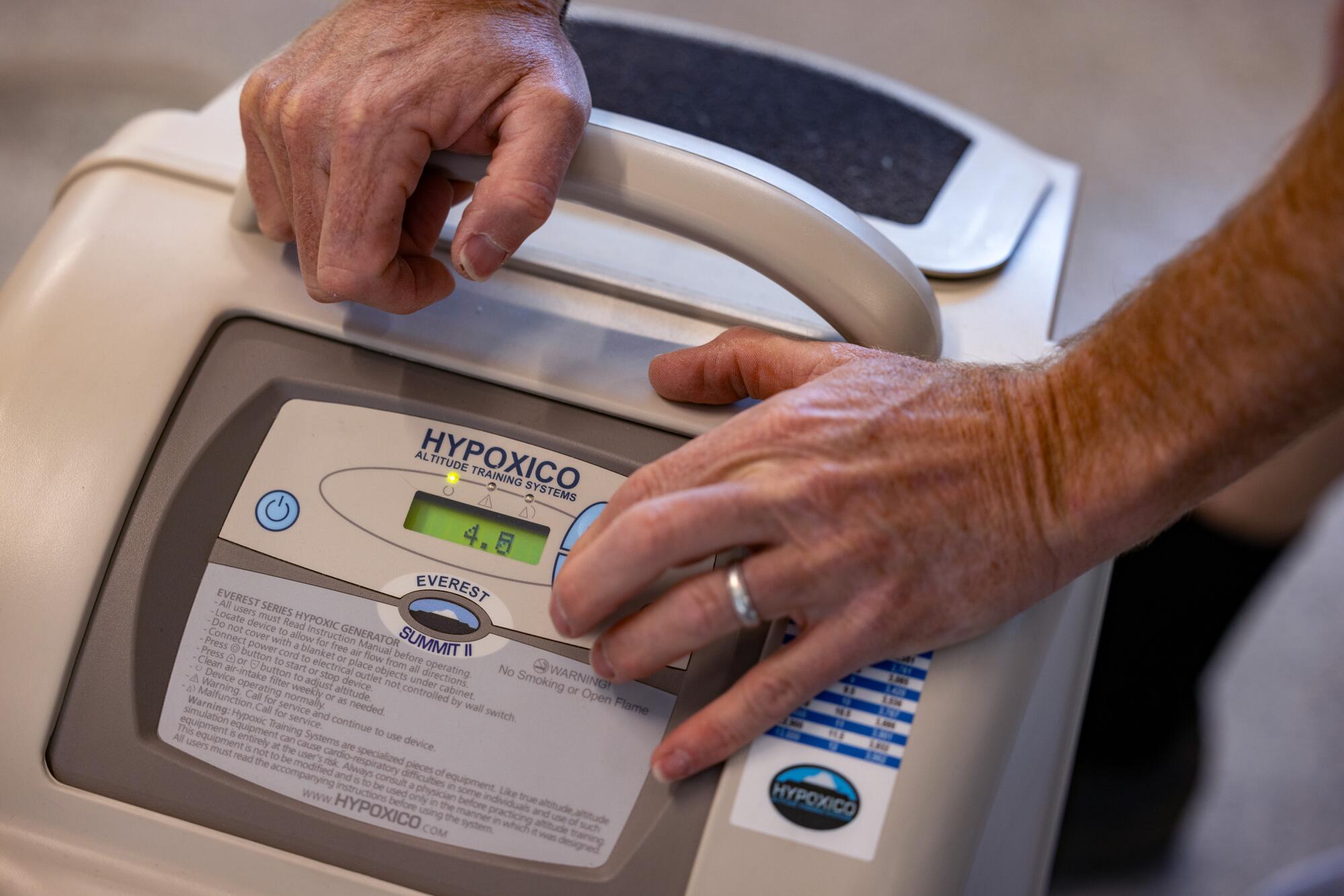
Mountain guide Adrian Ballinger says employing technology that allows clients to acclimatize to high elevations at home has allowed him to cut weeks off their expeditions to Mt. Everest.
Ballinger cuts nearly two weeks from his trips by driving his bedroom-acclimatized clients from the airport in Lhasa, Tibet, straight up to the northern route’s base camp, which is also at about 18,000 feet.
For some old-school purists, eliminating the long walk borders on sacrilege, said Will Cockrell, a journalist whose recent book, “Everest, Inc.,” explores the evolution of commercial guiding on the mountain. “They’ll say, ‘You’re not a real climber; you’re not a real nature lover,’” Cockrell said.
But since the arrival of big commercial expeditions on Everest in the mid-1990s — complete with Sherpas to install climbing ropes, chefs to cook meals in camp, team doctors to monitor health, and guides to accompany clients every step of the way — Mt. Everest has ceased to be a classic off-the-grid mountaineering challenge.
“It has come to represent something completely different,” Cockrell said, “something crazy to do to shake up your life, like running an Ironman.”
Ballinger makes no apologies. “We’re not old school, we don’t spend a lot of time sitting around drinking whiskey and playing cards,” he said.
That suits his clients, who “tend to be pretty type A, pretty high performing in everything they do,” Ballinger said.
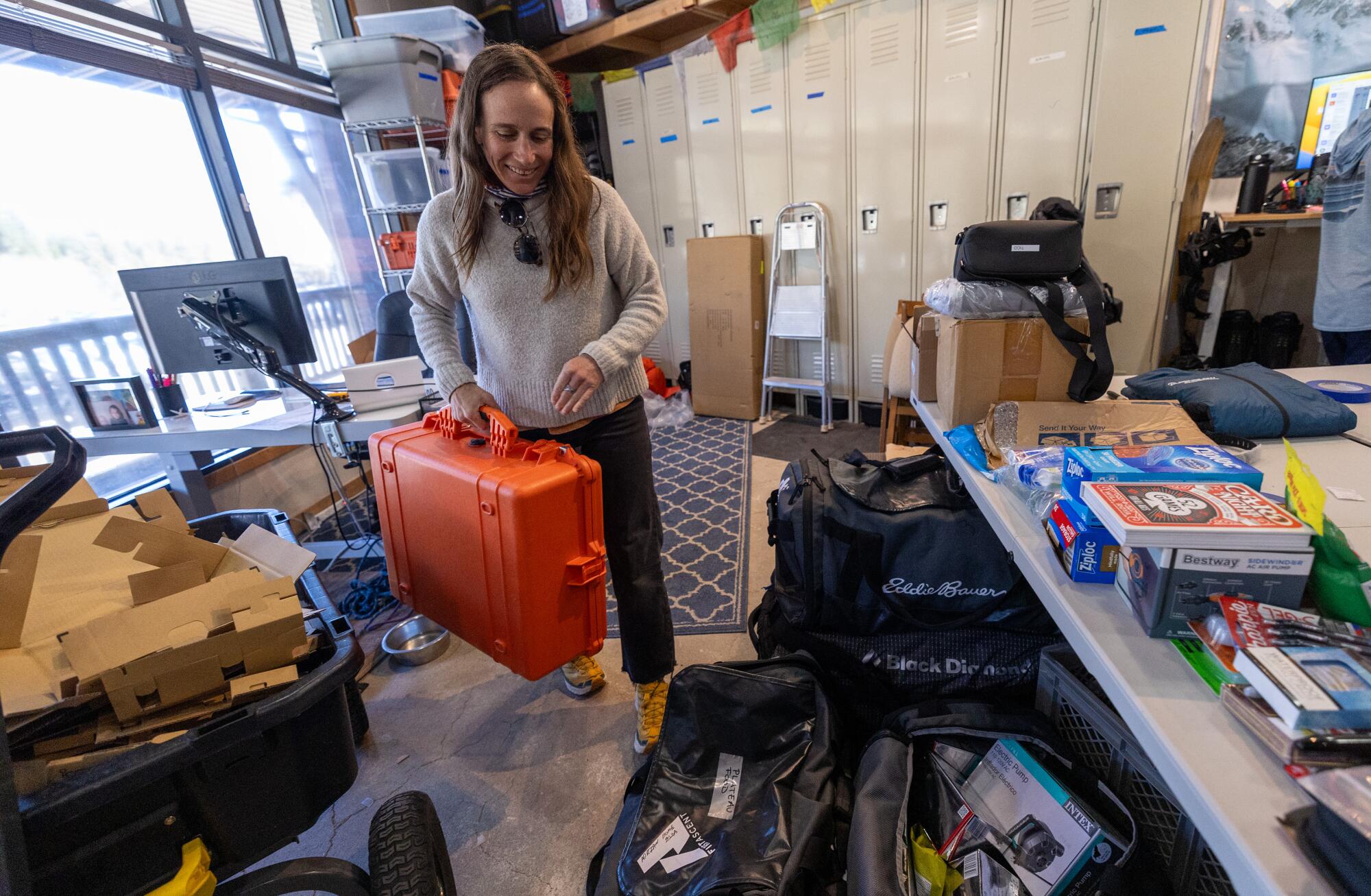
Emily Turner, Alpenglow Expeditions’ Everest base camp manager, organizes supplies for a May trip.
They’d better be. His company, Alpenglow Expeditions, charges $165,000 (before tip) for a private climb, meaning one professionally certified guide per client, and $98,000 for a group climb with three clients per guide.
“We’re proudly expensive,” Ballinger said. “I’ve spent a lot of time thinking about what it takes to run a trip safely and ethically, and this is what it takes.”
Climbing from the north side, as Ballinger does, avoids the huge crowds who flock to the southern base camp from all over the world every May, the prime climbing season on Everest, to wait for a brief window of good weather to try to make it to the summit.
Anyone who has even loosely followed events on Mt. Everest in recent years is probably familiar with the terrifying “conga line” photos of climbers stuck in the world’s highest traffic jam.
It forms just below the summit on the southern route, at the last technical obstacle, a nearly vertical 40-foot rock wall called the Hillary Step. It’s on a ridge with a 10,000-foot drop to the climber’s right and an 8,000-foot drop to the left. So, when exhausted and inexperienced climbers inevitably struggle there, everybody else waits in a single file, hanging onto a fixed rope, while the bottled oxygen they need to survive at that altitude slowly drains away.
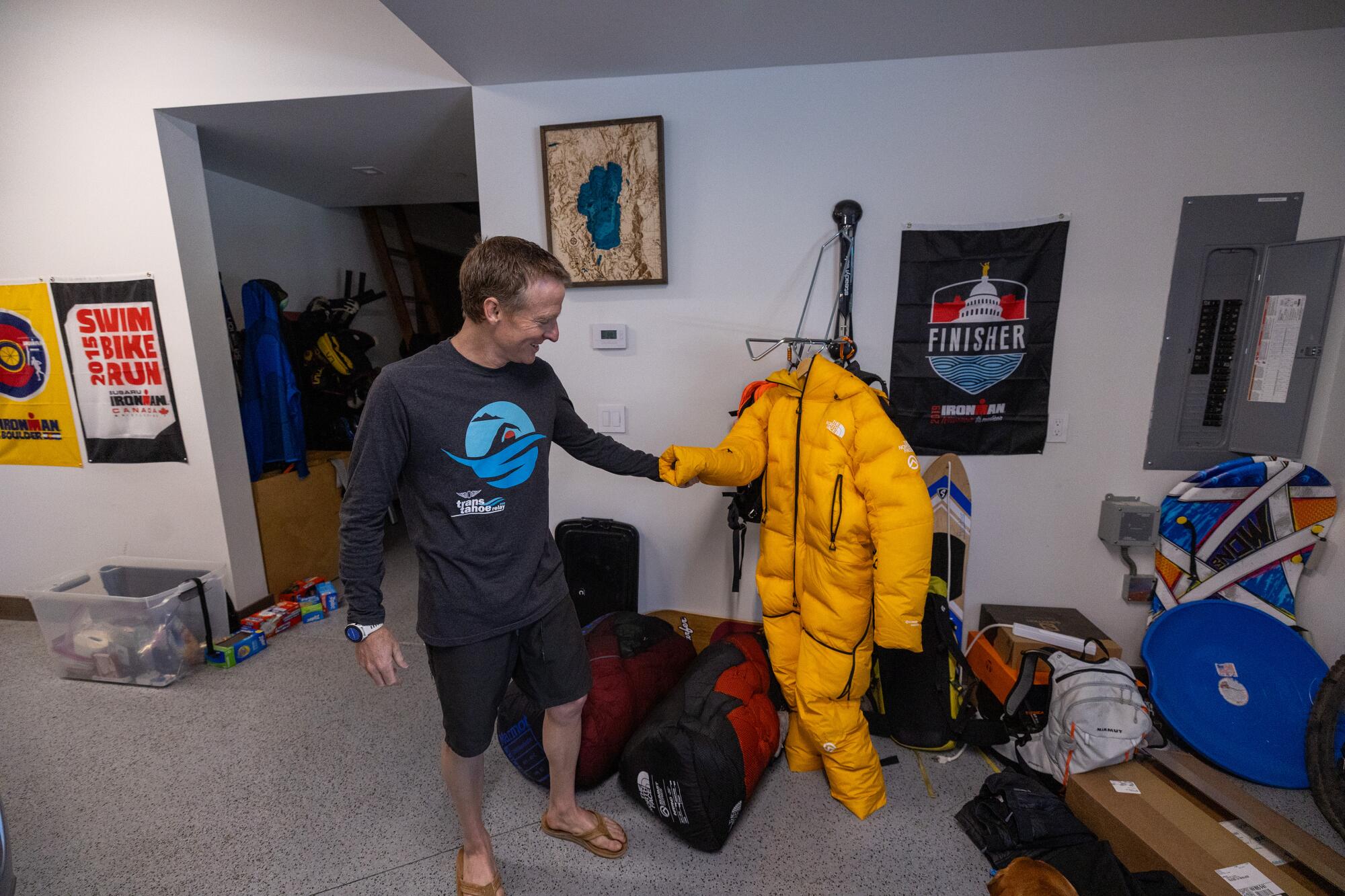
Graham Cooper is no stranger to grueling physical challenges. He has competed in the Ironman World Championship 11 times and has won the 100-mile Western States Endurance Run.
Worse is the Khumbu Icefall, a glacier just above the southern base camp. It’s best known for wide spine-tingling crevasses spanned by flimsy-looking aluminum ladders lashed together with rope. Climbers have to walk across those ladders, wearing big boots and crampons, as they make multiple trips back and forth to advanced camps to acclimatize before finally heading for the summit.
As dangerous as it is for the mostly foreign climbers and guides, the odds are even worse for the local Sherpas, who regularly traverse the Khumbu ferrying equipment — tents, food, oxygen canisters — for the climbing teams. Last year, the deadliest climbing season in Everest history, three Sherpas were killed in the Khumbu when a towering block of ice collapsed and buried them.
In six seasons climbing the southern route, from 2009 to 2014, Ballinger said he passed through the Khumbu 38 times and had two close calls. While nobody on his teams lost their lives there, he helped recover the bodies of other climbers who had not been so lucky.
Finally, he did the math and concluded there was no way he could get through a whole career — 20 or 30 years — without losing someone he was responsible for in the Khumbu.
“I just couldn’t do it anymore,” Ballinger said. “I just couldn’t justify the risk.”
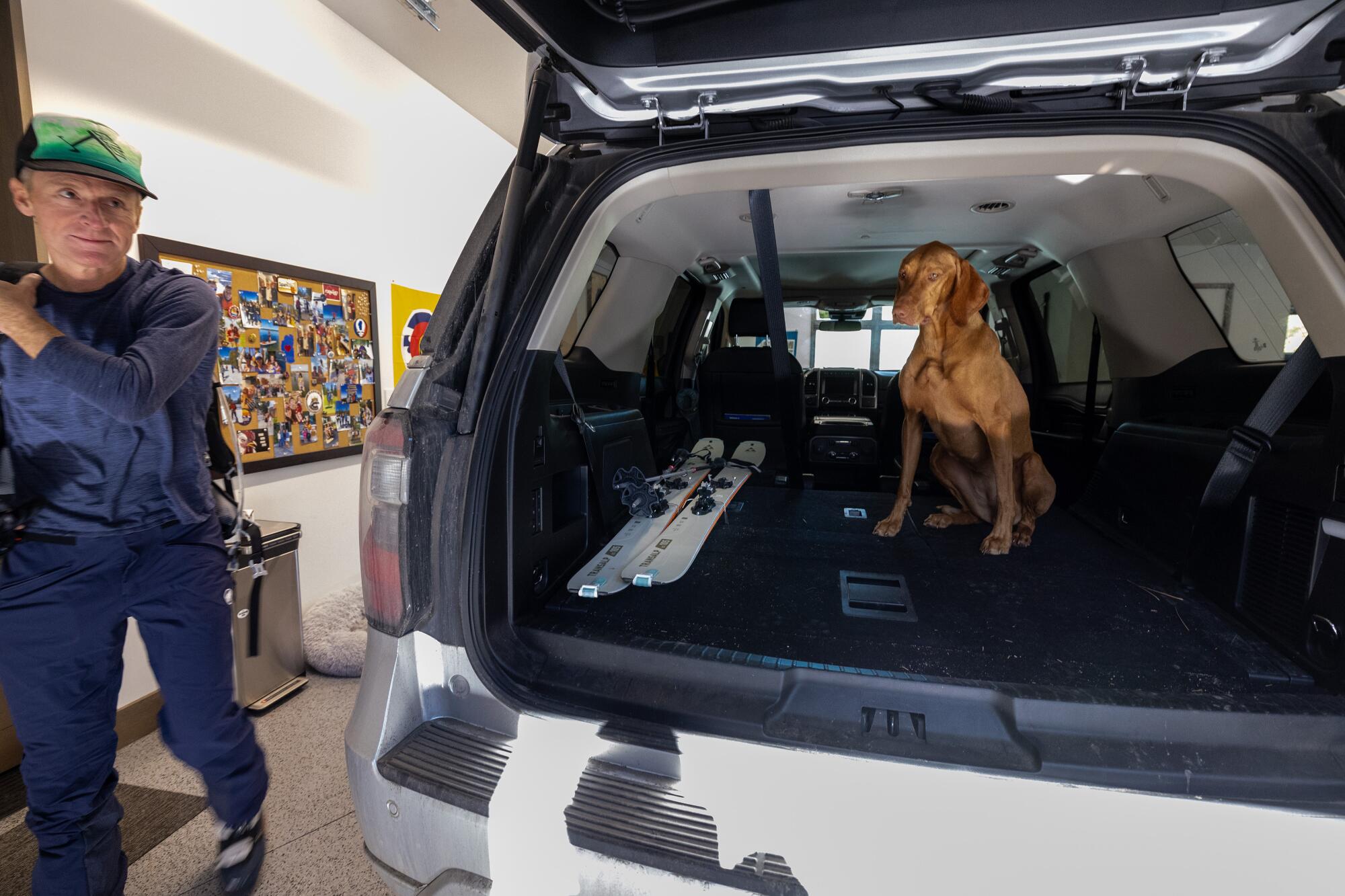
Graham Cooper loads skis into his SUV, preparing for a back-country exercise session with his loyal dog, Busy.
Ballinger’s data-driven approach and stellar track record were enough to win over Cooper.
And he has been willing to wait.
He was ready to climb Everest four years ago, but when China shut down expeditions to its side of the mountain in 2020 in response to the COVID-19 pandemic, Ballinger stuck to his principles and refused to resume climbing with the crowds in Nepal. This is the first year since the pandemic that the Chinese side has been open.
The Alpenglow team, which includes 26 clients, guides and Sherpas hoping to reach the summit, were originally scheduled to begin their expedition in late April. After a late permitting change from the Chinese government, that date has been pushed back to May 7.
Cooper has competed in the Ironman World Championship in Hawaii 11 times and has won the legendary Western States Endurance Run, a 100-mile ultra-marathon. He is not a man accustomed to sitting around. “I’m feeling ready and anxious to get going,” he texted a reporter last week.
When not trying to sleep in his hypoxic tent, Cooper has spent his training days in Tahoe on back-country skis doing laps up and down a mountain, his 3-year-old dog, a Vizsla named “Busy,” at his heels. Indoors, he straps on a hypoxic mask hooked to the same motor he uses for the sleeping tent and rides a stationary bike an hour at a time. Or climbs a StairMaster. Or throws on his mountaineering boots and a heavy backpack and trudges up and down slopes.
Why?
“I’m addicted to doing this kind of stuff,” said Cooper, who ran his first marathon when he was 13. “I just feel like a fundamentally happier person when I’m training.”
Ballinger leads clients on bucket list climbs all around the globe. Many of the treks present more interesting technical challenges than Everest. Almost all of them feel like wild outposts compared with the circus vibe on Everest’s south side.
Still, he gets poetic when he describes why so many clients are drawn to the world’s tallest summit.
“Because it’s so hard,” he said. It takes incredible fitness, mental fortitude and a heavy dose of luck to make it to the top. And no matter how many precautions you take, there’s that uncontrollable element of risk.
“It’s not just a battle for success, it’s a battle for survival up there,” Ballinger said. “That’s something that many of us have not experienced otherwise. I think that really captures people.”
Business
Studio owners revise plans for $1-billion update of historic Television City

The owners of Television City have scaled back their plans to enlarge and modernize the landmark Los Angeles studio where CBS began making shows to broadcast nationwide at the dawn of the television age.
Formerly known as CBS Television City, the studio sits next to popular tourist attractions the Original Farmers Market and the Grove shopping center in the Fairfax district where it has been operating since 1952 as a factory for such hit shows as “All in the Family,” “Sonny and Cher” and “American Idol.”
CBS sold the famous studio for $750 million in 2019 to Hackman Capital Partners, one of the world’s largest movie lot owners and operators. CBS continues to occupy Television City as a tenant.
An architect’s rendering of the planned office and production space at Television City, an entertainment studio in the Fairfax district of Los Angeles.
(Courtesy of Foster + Partners and Television City)
Hackman Capital announced a $1.25-billion plan two years ago to expand and upgrade facilities on the lot at Beverly Boulevard and Fairfax Avenue in hopes of harnessing strong demand in the region for soundstages, production facilities and offices for rent on studio lots.
Hackman Capital on Friday will update its application to the city to enhance the studio, saying it is responding to feedback about the project from nearby residents, stakeholders and city officials. If approved, the new project is expected to be completed by 2028.
The studio owners also brought in a new design architect, Foster + Partners. The London-based firm is led by Norman Foster, a prominent architect whose designs include the pickle-shaped Gherkin skyscraper in London and the master plan for the $2-billion One Beverly Hills condominium and hotel complex under construction in Beverly Hills.
Hackman Capital, which operates studios in the U.S., Canada and U.K., is also responding to changing conditions in the office rental market, which has contracted since the COVID-19 pandemic drove many companies to work remotely at least some of the time. Plans still call for creating new offices, but there would be fewer of them.
Foster’s new design eliminates a 15-story office tower on the west side of the lot, cutting 150,000 square feet of offices to rent to entertainment-related firms. Another 15-story office tower remains in the plan, but other building heights have been lowered, particularly along the perimeters, Hackman Capital said.

An architect’s rendering of plans for Television City.
(Courtesy of Foster + Partners and Television City)
The plan still represents an addition of more than 980,000 square feet to the 25-acre site at Beverly Boulevard and Fairfax Avenue that retains a suburban-style low-density appearance with soundstages, low-rise offices and support facilities flanked by asphalt parking lots.
The company’s proposal calls for combining old and new space to create 700,000 square feet of offices to support production on the lot and an additional 550,000 square feet of offices for rent to entertainment and media companies, the company said.
Office space behind studio gates is in high demand in the Los Angeles area and has been snapped up at other studios by such big Hollywood players as Netflix and Amazon.
“The industry wants to have a location where they can do production and have offices in a self-contained campus environment,” said real estate broker Jeff Pion of CBRE, who represents Hackman Capital. “Having all of the different components that make up production in one location is very attractive to the industry.”
Plans for Television City also call for a new commissary and more than four acres for production base camps. The streetscapes would be improved to be more visually appealing to passersby, with wider sidewalks.
On Fairfax Avenue, where pedestrians now pass by a fenced parking lot, there would be shops and restaurants serving the public on the ground floor of office buildings that could be reached only from inside the lot.
The separation is part of the balancing act Hackman Capital is attempting to make Television City feel more friendly to the neighborhood while retaining the security and exclusivity of a closed campus that appeals to celebrities and others who make movies and television shows.
Landlords can also charge a premium for office space on movie lots because they are close to the action for independent production companies and offer the cachet prized by many in the entertainment industry.
Filming activity in Los Angeles has fallen off substantially in the wake of strikes by writers and actors last year, according to FilmLA, a nonprofit organization that tracks on-location shoot days and filming permits in the region. The downward trend compounded a dip that emerged in late 2022 as on-location filming in Los Angeles took a dive as studios pared back movie and TV production that surged during the COVID-19 pandemic.
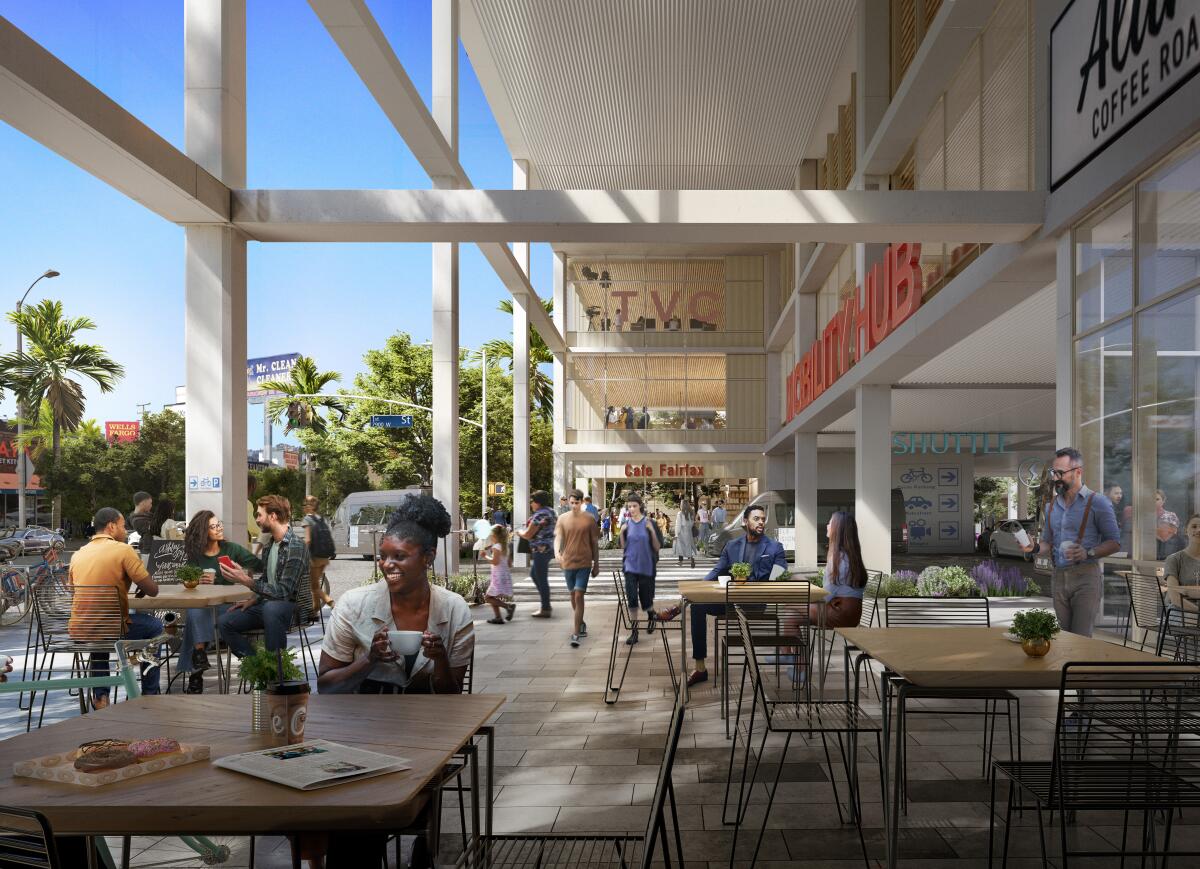
A rendering of the entrance to the planned mobility hub on Fairfax Avenue where shuttle buses from a nearby subway station would come and go.
(Courtesy of Foster + Partners and Television City)
California is finding it particularly hard to rebound from the strikes because it’s more expensive to shoot here, multiple production executives told The Times. That makes Los Angeles less attractive to studios looking to cut costs after major industry disruption.
To Hackman Capital Chief Executive Michael Hackman, the downturn and filming pullback from California suggest that regulators and studio operators should further support production companies.
“Our actual customers tell us all of them want to stay in Los Angeles,” he said. “We have the best crews in the world here, but we don’t have enough modern soundstages in premier locations. We also have to push the state on tax incentives so that we don’t lose business outside of the city.
“The entertainment industry is our city signature industry and if we don’t invest in the future, we’re really at risk of losing it,” Hackman said. “We’re still emerging from a once-in-a-generation dual strike. And the production stoppage cost Angelenos approximately $6.5 billion or more in lost wages and economic activity, which makes it clear how important this industry is to our city, and especially the people who work in entertainment every day.”
Hackman Capital’s proposal calls for raising the number of Television City stages to at least 15, from 8, along with production support facilities.
To make room for the planned additions, parking would be converted from surface lots to garage structures and underground spaces capable of parking 4,930 vehicles.
Two stages built in the 1990s on the east side of the lot would be demolished as part of a planned reconfiguration of the site.
The four original stages built by CBS in 1952 would be preserved along with other historical design elements created by Los Angeles architect William Pereira, who also designed such noteworthy structures as the futuristic Theme Building in the middle of Los Angeles International Airport and the Transamerica Pyramid office tower in San Francisco.
Pereira’s long-range plan for Television City conceived in the 1950s was expansive, said Bob Hale, creative director of Rios, the master plan architect of Hackman Capital’s proposed makeover. Hale said Pereira’s original concept called for the complex to grow to 24 stages and 2.5 million square feet of production space, including several multistory office buildings.
“It was built in a way that it could be disassembled and incrementally extended,” Hale said. “For a number of reasons, that didn’t happen.”
In an effort to make it happen now, Hackman Capital set out to get the support of Councilwoman Katy Yaroslavsky and the surrounding community. Over five years, the company met with nearly 3,000 neighbors, Hackman Capital said.
Among the groups supporting the project are the Holocaust Museum LA, Los Angeles Conservancy, Los Angeles/Orange Counties Building and Construction Trades Council, Mid City West Neighborhood Council and FilmLA, Hackman Capital said.
The first proposal drew fire from neighboring businesses the Grove and Farmers Market, which sent letters to residents in 2022 calling the Television City project a “massively scaled, speculative development which, if approved, would overwhelm, disrupt, and forever transform the community.”
In July 2022, an executive representing Grove owner Rick Caruso appeared before a committee of the Mid City West Neighborhood Council and said the Television City project would create “complex” issues for the neighborhood, including traffic, parking and construction. Caruso himself has said he does not oppose the redevelopment of Television City.
The Beverly Fairfax Community Alliance, which was founded by the Grove and Farmers Market, has been more blunt, warning that the expanded site would clog Fairfax Avenue, Beverly Boulevard, La Brea Avenue and 3rd Street with traffic.

The signature red awning at Television City as seen from Beverly Boulevard.
(Courtesy of Foster + Partners and Television City)
“Even those accustomed to living with L.A. traffic and parking nightmares will be shocked at how much worse it can be,” the group said on its website.
To address such concerns, Hackman Capital said the new plan will reduce the number of estimated daily car trips to Television City by 5,000 to 8,700. The landlord also plans to move its “mobility hub” from The Grove Drive on the east side to Fairfax at 1st Street on the west side of the lot. The mobility hub would serve public transit, rideshares and other passenger drop-offs as well as employee shuttle buses to the subway stop being built at Fairfax and Wilshire Boulevard.
“Our goal with Television City, particularly along the perimeter on our public edges, was to find a really great interface with the community. So it wasn’t just a studio with a blank wall, but we were active and engaged,” said Brian Glodney, a development executive for Hackman Capital.
Community members told Hackman Capital said they want the streets outside the studio to have a sense of connection between mom-and-pop businesses on Fairfax, the Farmers Market, the Grove and Pan Pacific Park, Glodney said.
Outlets on the edge of the lot such as shops and restaurants will be limited to a total of 20,000 square feet, he said, “just enough to help activate the streets but not compete with our neighbors.”
-

 News1 week ago
News1 week agoIs this fictitious civil war closer to reality than we think? : Consider This from NPR
-

 World1 week ago
World1 week agoShipping firms plead for UN help amid escalating Middle East conflict
-

 Politics1 week ago
Politics1 week agoICE chief says this foreign adversary isn’t taking back its illegal immigrants
-

 Politics1 week ago
Politics1 week ago'Nothing more backwards' than US funding Ukraine border security but not our own, conservatives say
-

 News1 week ago
News1 week agoThe San Francisco Zoo will receive a pair of pandas from China
-

 World1 week ago
World1 week agoTwo Mexican mayoral contenders found dead on same day
-

 Politics1 week ago
Politics1 week agoRepublican aims to break decades long Senate election losing streak in this blue state
-

 World1 week ago
World1 week agoBrussels, my love? The EU single market is not sexy enough for voters


/cdn.vox-cdn.com/uploads/chorus_asset/file/25426368/IMG_4517.jpg)
